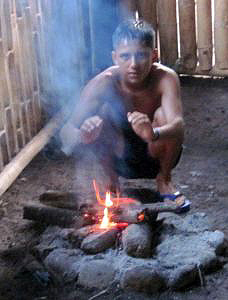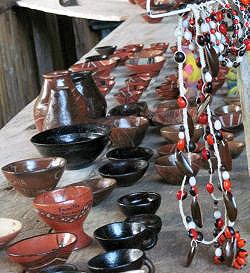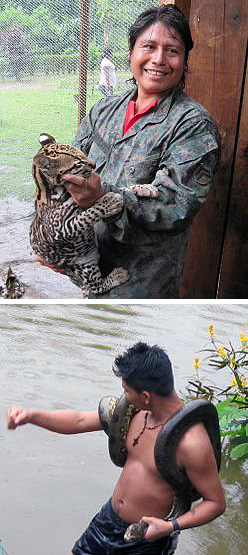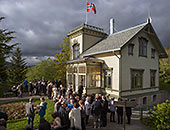 |
 |
|
 |

|
The Lure of the
Amazon
Story & Photos by Richard Frisbie
Until, that is, the subject line of a recent email caught my eye: Andean / Amazon / Galapagos Tour Invitation. There, in my Inbox was a description of a trip exploring the wonders of Ecuador; the natural, historical and architectural world that straddles the equator, and goes from the shores of the Pacific, over the heights of the Andes, down into the Amazon Basin. I was hooked! My reply said it all: Sign Me Up! The Amazon leg of the journey was a five hour drive from Quito, the capital of Ecuador. With an altitude of 9300 feet, Quito is the 3rd highest capital in the world. Our route climbed the Andean peaks towering over Quito and descended nearly two miles in elevation into the Napo River Valley far below. The Napo River is the last unbridled tributary of the great Amazon River. Our Destination: Cotococha Amazon Lodge on the Napo River, outside the city of Tena.
Cotococha is an ecological lodge that sits very lightly on the edge of the Sumaco, Cayambe and Cuyabeno Reserves. The 21 otherwise comfortable guest cabins have no electricity, and the running water is barely filtered river water. The flush toilets empty into modern drainfields, and the soap and shampoo are completely biodegradable. Fresh drinking water is provided daily, as are all meals. Every tendril of the waste stream is planned, monitored, and managed to insure the most ecological and environmentally sound sojourn in the jungle. So much care is taken not to interfere with the flora & fauna that, should an insect (or worse) get into the screen-walled cabin, guests are asked not to kill it, but to release it back outside. The lodge is located at an elevation of about 1600 feet, really the high end of the Amazon Basin. That ensures a lessened danger of Yellow fever and malaria. I was advisedly covered with insect repellent (Deet) and sunscreen (60 SPF) during my visit, and received neither bites nor burns the entire time. Whether you take the prudent precaution of injections and balms is entirely up to you. I did not deem it necessary to pay as much as $300 for the vaccinations and medication others might desire. I did see one mosquito, but I see more than that any evening at home in New York’s Hudson Valley. Of the many excursions the knowledgeable staff at Cotococha Lodge offer, the boat ride downstream to the Wildlife Rehabilitation Center appealed most to me. Others preferred the jungle hikes, and tubing or rafting the Class four rapids upstream. Fortunately, the boat ride included a visit to the Quichua (indigenous peoples) settlement closely associated with the Lodge. On my brief overnight stay I was able to see diverse wild animals and learn about the culture of the mainly highland Indians who share the Quichua language. Both were accomplished after a thrilling motorboat traverse of the Napo River rapids.
The Quichua village, more a neutral-ground community structure outside both the lodge and the village, was reached after climbing up a slippery, muddy path from the river. As I passed a lone flip-flop stuck in the quagmire I remarked yet again upon what inappropriate footwear it was. The women of the village showed us their craftsmanship, making the popular local drink “chichi de yucca”, and ceramic pottery from local materials. We sat on long benches, passing bowls to taste and admire, as 2 campfires smoldered at either end of the open-air, thatch-roofed shelter. Some pubescent youths returned from a river swim to warm themselves by the fire. Others helped the women display the finished pottery, which was for sale. I purchased a small, unfired bowl, for $2. It was decorated with the Jungle Woman design using a feather paintbrush, and “glazed” with the resin of a tree. It is air-dried, fragile, and a beautiful addition to a collection of bowls I’ve acquired from all over the world.
At the wildlife sanctuary, a Quichua shaman walked us through the jungle explaining the medicinal properties and uses of the shrubs and trees we encountered. He described compounds such as curare, (a paralyzing drug used on arrow tips to immobilize prey), the date-rape drug, (a handful of twigs boiled in three liters of water will reduce to a compound that when slipped into a drink makes a slave of the recipient. Contrary to the drug’s popular name, unscrupulous people primarily use it to get you to willingly drain your ATM account.) and “dragon’s blood”, (the red sap from a tree which can be used as a salve to rub on insect bites and scratches.) There were also plants with hallucinogenic properties, and others that were downright poisonous. It is estimated that only a tiny percentage of the plants with beneficial properties in the Amazon Basin have been identified by modern science. I got the impression that the native shaman knew many more.
The wildlife was another matter. As excited as I was to actually see the birds, snakes, and mammals on display, I was sad to realize that they were too acclimated to human presence to be released back into the wild. Once the animals are returned to good health they are basically inhabitants of a petting zoo. The most thrilling part of the visit was when a young native slipped into a muddy pond and wrestled a 12 ft Anaconda to shore. The sight of the magnificently patterned snake’s skin wrapped tightly around his naked torso had me reliving all the vivid nightmares of my youth, but with a morbid fascination. Later when I asked him how many times a day he performed that feat, he showed me his many scars from snake bites as he held up three fingers. As I said, I am ambivalent about the nature of the “sanctuary”, but aware of the realities of the costs associated with running it. For the price of admission ($2.50) I saw more in one day than I could hope to see if I had weeks to spend in the Jungle. It was a small price to pay to help further the rehabilitative efforts of the center. I would have been content if that had been my only brush with Amazonian wildlife. Our “cabins”, basically thatch-roofed, screened platforms, were spacious and comfortable. We sat on my porch drinking wine and listening to the river and the night sounds close in after a simple, but hearty dinner. I bid my companions goodnight, took a shower and went to bed. Later, half-asleep, I felt my bed move, and then my pillow. I imagined, dreamed perhaps, that I was home in my own bed and my cat had just joined me as she does every morning. She tries to wake me so I will feed her, but, if ignored, she’ll curl up and go to sleep. I was waiting for her to do just that when two things happened. I felt my hair move just as I remembered where I was, or wasn’t. Because Immediately I was out of bed, standing naked in the middle of the darkened cabin, screaming like a little girl.
When I finally found my flashlight there was nothing to be seen. Trust me – I looked everywhere. It was pitch black outside and pouring rain. There was nothing to do but imagine my strange bedfellow smaller and smaller until it was gone, and I felt safe enough to climb back under the carefully examined and re-examined covers to wait out the night. At first light I dressed in my still-wet clothes and fled to the electrified kitchen area. Our driver came after breakfast for the return trip over the mountains back to Quito. The meals at Cotococha Amazon Lodge were well-prepared
and presented buffets of good food. (This was not the culinary leg of
the tour.) The staff was friendly and solicitous of everyone’s
well-being. The facility was charmingly attractive in a rustic, handcrafted,
environmentally correct kind of way. The guests were an interesting
mix of singles, couples and groups representing all nationalities and
ages. The downpour never stopped, leading me to finally realize why
the Amazon is called a rain forest. All-in-all, I was as glad to be
there as I was happy to leave. The experience was amazing, including
my “nightmare” bedfellow! The Amazon is something I should
have “conquered” long ago. If You Go: Comments and/or questions can be directed to Mr. Frisbie at hopefarm@hopefarm.com |
|
|
| |||
This site is designed and maintained by WYNK Marketing. Send all technical issues to: support@wynkmarketing.com

|





















